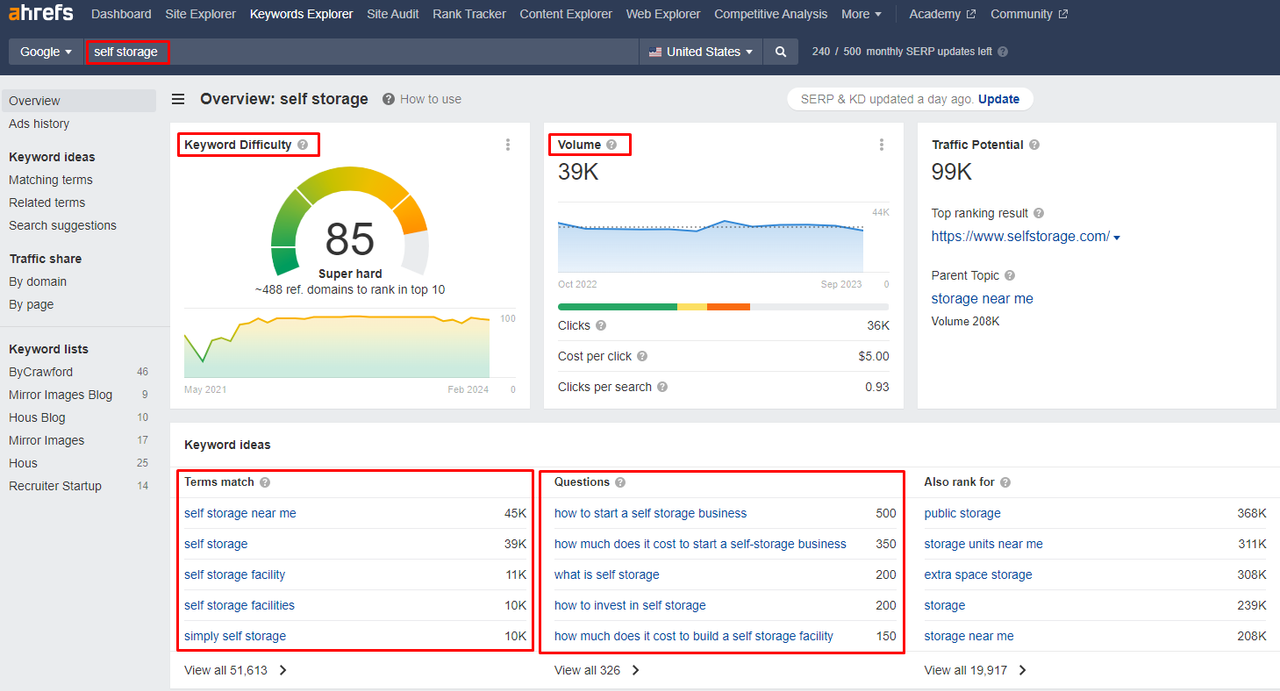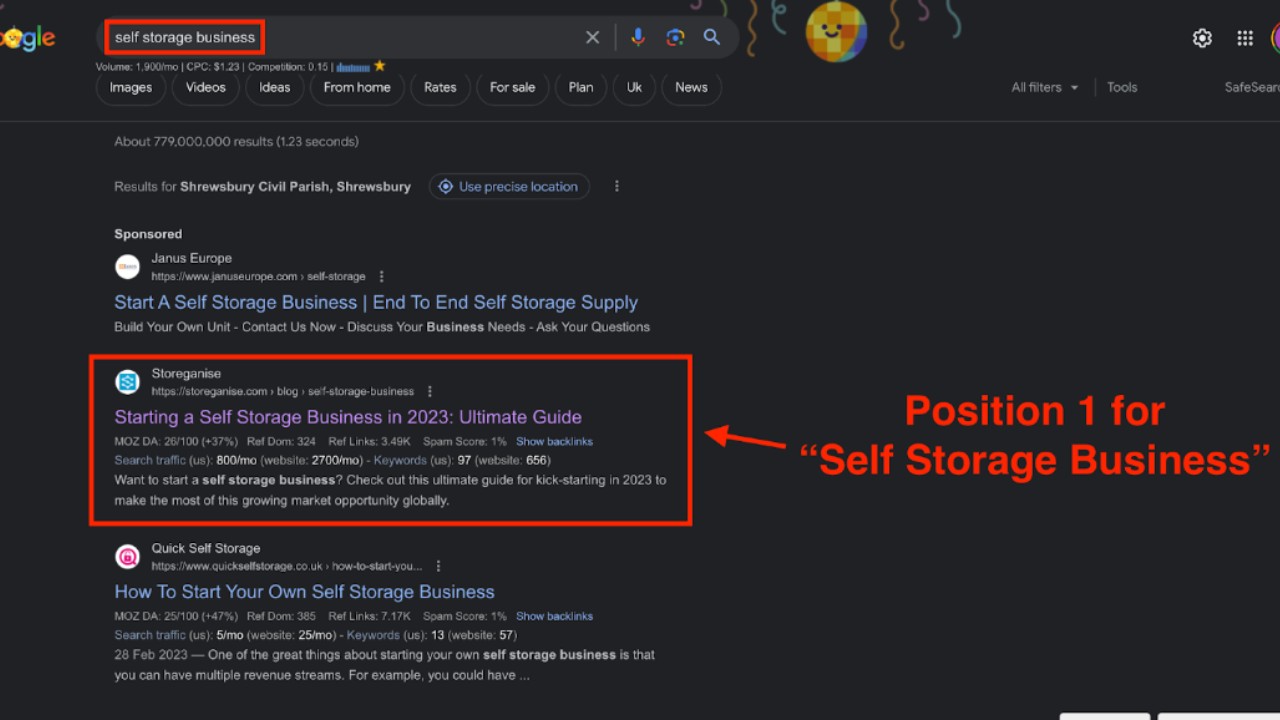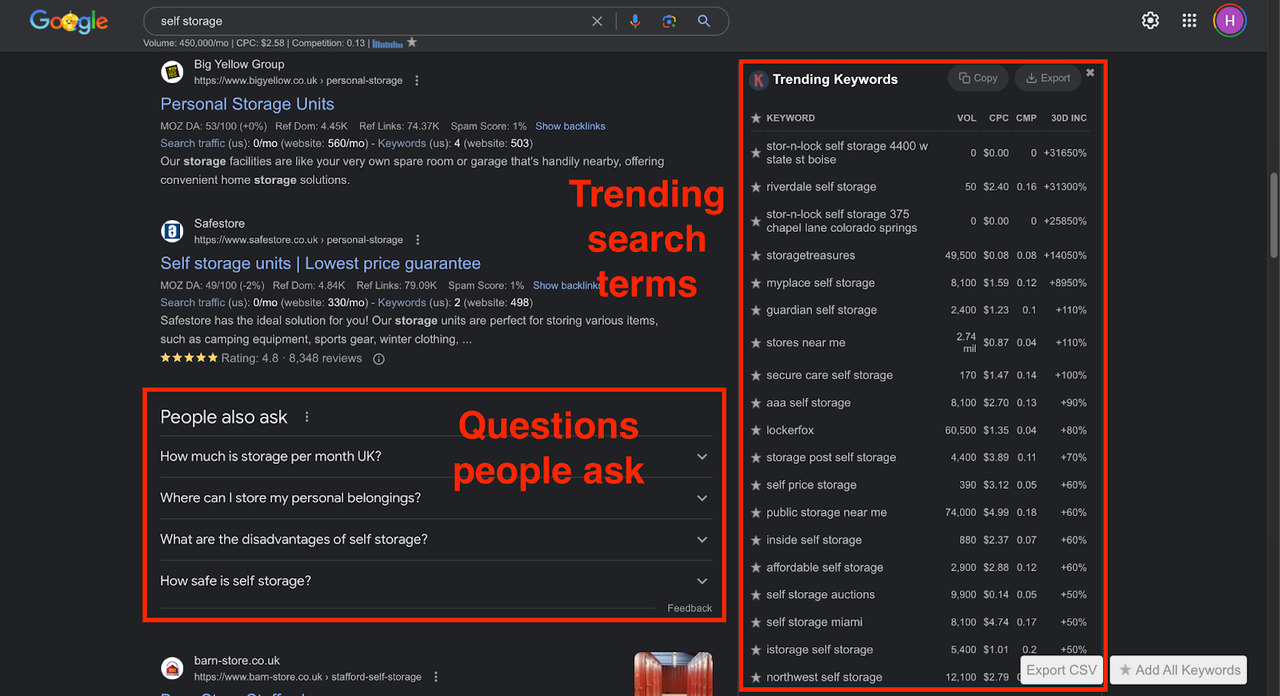
Self Storage SEO: Ultimate 2025 Guide [+ Free Download]
The self storage market is experiencing rapid growth, with over 1.5 billion square feet of storage space built in the last few years. However, this boom also brings increased competition. Implementing effective SEO strategies can help your storage facility stand out, attract more customers, and increase occupancy.
In this self storage SEO guide, we will show you how to rise above the competitors, attract inbound leads and fill your storage units.
What Is Self Storage SEO?
Self storage SEO, or search engine optimization, is the practice of optimizing your website to enhance its visibility on search engines like Google. This involves various strategies and techniques to improve your website's ranking in search engine results pages (SERPs) for keywords and phrases relevant to your self storage services. For example, when potential customers search for terms like "self storage units near me" or "climate-controlled storage," effective SEO helps ensure that your website appears higher in the results
By appearing higher in SERPs, your website attracts more organic traffic, meaning visitors who find your site through unpaid search results. Increased organic traffic is crucial because it drives more potential customers to your site, leading to higher occupancy rates and increased revenue for your storage facility.
Additionally, local SEO plays a significant role in ensuring your business appears in local search results and Google Maps when users search for storage facilities in their vicinity. Overall, self storage SEO is a cost-effective way to enhance online visibility, attract more customers, and boost your business's growth.
Why Is Self Storage SEO Important?
Self storage SEO is vital for increasing your facility's online visibility and attracting local customers. Most potential clients search for nearby storage options, and effective SEO ensures your business ranks higher in search results.
This leads to more organic traffic, higher occupancy rates, and reduced reliance on expensive paid advertising. Additionally, a well-optimized website builds trust and credibility, making converting visitors into paying customers easier.
In a competitive market, robust SEO strategies give you a significant edge over competitors, driving sustainable growth and long-term success.
For self storage businesses, doing digital marketing and self storage SEO is crucial for the following reasons:
- Increased website traffic
- Enhanced online visibility
- Targeted audience
- Competitive advantage
1. Increased Website Traffic
According to SEO reports, 53.3% of all website traffic comes from organic search. By implementing effective SEO techniques, self storage facilities can significantly boost website traffic. For example, one of our clients saw a 150% increase in organic traffic within six months of implementing our SEO strategy.
2. Enhanced Online Visibility
SEO helps improve your website’s visibility in search engine results by ensuring your website ranks higher up SERPs. This is important considering that first page results on Google enjoy 95% of all search traffic.
3. Inbound leads
Inbound leads (i.e. the ones that come through SEO) are 8.6 times more likely to close than outbound leads. This is because they’re actively searching on Google for a solution to their problem, such as self storage, and find the solution at the time they’re ready to buy.
4. Reduced Cost Per Lead
Google ads are only getting more expensive, and self storage is getting more competitive. This leads to higher costs-per-lead and lower margins. What's more, when you stop paying for ads, the leads stop—the opposite is true with SEO.
Complete Self Storage SEO E-Book
Download Your Free Guide
Download the self storage SEO e-book - built from experience working with self storage businesses across the globe, and taking Storeganise from 5 inbound leads/month, to 50-60/week.
Storeganise’s SEO Success With ROUGH WATER MEDIA's Self Storage SEO Services
With ROUGH WATER MEDIA’s self storage SEO services, we were able to:
- Increased website traffic
- Drive 19.7x increased organic web traffic to our website in just 7 months
- Consistently secure at least 50–60 inbound leads weekly
- Gain media coverage on high-authority websites like Yahoo Finance, AccessWire, GuruFocus, WallStreet-Online
- Rank #1 on Google’s first page for self storage search terms like “self storage software” and “self storage business”
Miles Davison, CEO of Storeganise, shares, 'ROUGH WATER MEDIA's SEO strategies have transformed our online presence. We now dominate the search results and have seen a substantial increase in leads and revenue.
Check out this interview where Storeganise CEO Miles Davison shares the company’s testimony of choosing ROUGH WATER MEDIA as their go-to self storage SEO company.
Storeganise Testimonial for ROUGH WATER MEDIA
That said, what are the steps involved in a strategic SEO approach for self-storage businesses, and how can you implement them? Keep reading to learn more.
Prefer Video? Watch the self storage SEO guide on YouTube
In this video, ROUGH WATER MEDIA Founder, Henry Purchase, walks through the self storage SEO process in 9 steps, so you can attract inbound leads.
5-Step Self Storage SEO Guide
Navigating SEO for your self storage business can be challenging, but it's essential for boosting your online presence and attracting more customers. ROUGH WATER MEDIA has crafted a comprehensive five-step guide to simplify this process.
These steps help you effectively implement SEO strategies, from understanding the basics to leveraging advanced techniques.
By following this guide, you can optimize your website, improve your search engine rankings, and drive more organic traffic, ultimately increasing occupancy and revenue for your self storage facility.
1. Understand the foundations of a successful self storage SEO campaign 2. Leverage local SEO tactics for your self storage company. 3. Create compelling content for self storage SEO. 4. Consider technical SEO aspects for your self storage website. 5. Utilize tools for tracking and reporting your self storage SEO performance.Step 1. Understand the foundations of a successful self storage SEO campaign.
Start your journey to dominate the self storage search results by understanding the foundations of an effective SEO strategy. Keyword research and both on-page and off-page optimization form the core of your strategy.
1. Keyword Research
The foundation of any SEO strategy is identifying the right keywords. Otherwise known as search queries, keywords are those words and phrases that searchers input into search engines when searching for your services.
If you don’t know what terms your target customers are searching for on Google, how do you expect to rank your website and get found?
Start by conducting keyword research to determine which keywords your target audience is searching for. Then, optimize your content and metadata around those keywords. (We’ll cover more on this later on in this post).
For most self storage businesses, the main keyword you need to go after/optimize your site for is “Self Storage Units Your Location”, for example “Self Storage Units New York” - this is typically what consumers search when looking for self storage.
For example, here are keyword recommendations from Ahref for “self storage.”

Note these important metrics: KD and Volume. KD stands for keyword difficulty, which measures how hard it will be to rank for that keyword on a scale of 100. Volume is how many searches the keyword had in the last 12 months. You should target keywords with lower difficulty since they signify less competition.
Select a keyword to view related terms and frequently asked questions.

Adding related terms to support the main keyword you’re targeting improves your chance of ranking higher.
Similarly, search engines often show websites with answers to a question at the top of search results. Creating a section to answer frequently asked questions for the target keyword will improve your chance of ranking higher.
As you can see below, we’re able to rank in position 1 for the keyword “self storage business.”

Apart from keyword research, there are many other SEO considerations, like local SEO, content optimization, and technical SEO. We’ll explain how you can do this in the later part of this guide.
2. On-Page Optimization
On-page optimization refers to optimizing your actual website content and code to rank higher in search engines.
In addition to keyword optimization, make sure your site has a mobile-friendly responsive design, fast loading times, and secure HTTPS. Ensure your website has a seamless user experience and a clear call to action for website visitors—an essential SEO factor and something you may need to work with a web designer on. Further insights on these topics in upcoming sections.
We’ll explore more on these topics in subsequent sections.
3. Off-Page Optimization
Off-page optimization focuses on building high-quality backlinks to your website from other authoritative industry websites. According to reports, high-ranking results on search engines have 3.8x more backlinks than low-ranking results. Backlinks are important for SEO since they inform Google that your website offers informative and helpful content.
Guest blogging, digital PR, and influencer marketing are some of the best ways to gain valuable backlinks for your self storage business.
We have received significant success through writing about “self storage trends” — journalists are always looking to add unique statistics and facts into their articles. If you can be found when they’re looking to do this, you’ll get some heavy-hitting backlinks. This was how we were able to get featured in Yahoo Finance, as shown below.

Reach out to self storage associations and pitch contributing a blog post or being featured in a roundup article in exchange for a backlink. Make sure any backlinks you build use your main keyword, e.g., “self storage business, New York,” in the anchor text. Over time, building a portfolio of high-quality backlinks will strengthen your domain authority and search rankings.
The next thing to do is to exploit local SEO for your self storage business, and setting up a Google My Business (GMB) profile is the first step.
Step 2. Leverage local SEO tactics for your self storage company.
Local SEO for self storage is key for storage companies looking to attract more customers from their area. Recent statistics indicate that 46% of searches have to do with location, while 97% of users search online to locate a local business. With a strong local presence in search results, you can guide potential renters right to your facility’s front door.
Optimizing your Google My Business listing and enhancing your local citations can guide potential renters to your facility.
1. Optimize your Google My Business listing.
Your Google My Business (GMB) profile is your self storage facility’s home base in the local search universe. It allows you to create a local directory for your self storage business, which will often appear first in Google Maps for relevant keywords, as shown below.

Ensure all of your business information—like address, phone number, and hours—is current and consistent across platforms. Consider uploading high-quality photos of your self storage facilities—especially the front entrance—to help customers recognize and locate your business.
You may also embed an interactive Google Map on your contact page to make it easy for people to find you!
Encourage your happy renters to leave reviews on your GMB listing. Reviews are social proof that builds trust and credibility, which leads to more calls and walk-ins. Over 99.9% of consumers check reviews when shopping online, while 98% of consumers say ratings and reviews influence their purchase decisions.
Ensure your business hours are up-to-date since Google will display the locations that are open once a search is made. Also, aim to have as many reviews as possible — the goal is to surpass your competitors.
You can do this by printing off your Google My Business QR code and putting it on your front desk, as well as move-in welcome packs, so your customers can easily leave a review.
Here’s a video the ROUGH WATER MEDIA team made on this topic:
Don’t forget to respond to each review—especially the bad ones—to show you value customer feedback. A surprising 53% of customers expect businesses to respond to negative reviews in 7 days.
2. Boost your local citations.
Local citations have been found to have a 13.3% influence on search engine rankings. Local citations are listings on sites like Yelp, Facebook, Bing, and Apple Maps. The more places your self storage business is listed, the more discoverable you become.
However, all information must be consistent across platforms. Double-check details like your business name, address, and phone number to avoid confusion.
You can add many of these listings yourself for free. For an even bigger local SEO boost, consider using a citation-building service, such as those from BrightLocal and Semrush, to acquire listings on 50–100+ sites.
In step 1, we discussed the importance of keyword research in SEO for self storage. Going forward, we’ll explore one important area where you can exploit the strengths of keywords to help rank your website on the first page of SERPS — content.
Step 3. Create compelling content for self storage SEO.
Content is king!
According to reports, businesses who publish blogs on their website enjoy 55% increased traffic and 434% more search engine-indexed pages (i.e., those pages of a website that have been analyzed and included in a search engine’s list of pages for ranking).
The content on your website is like a magnetic force drawing people in. Producing informative blog posts, FAQs, and other content aimed at addressing common questions and concerns of self storage customers will boost your SEO efforts.
Regular blogging, keyword optimization, content promotion, and utilizing user reviews are potent strategies to convert visitors into customers.
Regular blogging, keyword optimization, content promotion, and utilizing user reviews are potent strategies to convert visitors into customers.
1. Blog regularly.
A consistent blogging schedule, with new posts 2–3 times a month, helps build familiarity and trust with potential customers. Blog about topics that address common questions and concerns, like how to properly pack and organize storage units or tips for saving space. Share behind-the-scenes details about running your facility or highlight a long-time customer’s experience. Your blog gives you a platform to start a genuine conversation with your audience.
2. Optimize for keywords.
Be sure to optimize your blog posts for keywords that support your primary keywords. Don’t write blog posts around your primary keywords since this will conflict with your landing page, which should be optimized for your primary keyword. Instead, aim for keywords users are actively searching for to capture them at different stages of your sales pipeline.
Naturally integrate these keywords into your post titles, URLs, image alt text, and content. This helps search engines understand what your content is about and rank it higher in results. You can also include related terms, such as “public storage,” “mini storage,” or “portable storage.”
Use precise keywords that directly address a user’s query, such as “What to store in a storage unit.” Add these keywords to your H1, meta description, and at least one other section of the article. For instance, a blog title that reads “What to Store in a Storage Unit: Complete 2024 Guide” can significantly enhance your visibility since customers seeking storage facilities are likely to search for this keyword.
3. Promote your content.
Don’t just publish and forget; promote your new blogs on social media to increase traffic and shares. Post snippets or eye-catching images on platforms like LinkedIn, Twitter, and Facebook, and engage with anyone who comments or shares your content.
Remember, only a small fraction, about 3%, of your target customers are prepared to make a purchase immediately. Hence, generating content that caters to customers at various stages of their buying journey can create an invaluable pipeline of potential leads for future conversions.
Consider using tools like Answer Socrates, which will show you the questions people are actively searching for. You may also use Keywords Everywhere to find relevant keywords for trending searches.

In addition, look for opportunities to reference your blog in email newsletters, on your website, and in other self storage marketing materials. Backlinks from industry websites or local organizations also give your content more authority in the eyes of search engines.
4. Show off user reviews and social proof.
Almost 50% of customers trust reviews as much as personal recommendations from family and friends, so ensure you build credibility by gathering reviews and testimonials from happy customers. Feature their reviews and stories on your website or in blog posts. You can also highlight positive reviews from sites like Google, Yelp, or the BBB. This social proof shows potential customers that others have had a good experience with your facility.
You can add the logos of any association you are in to support your credibility. You can also embed the logos of any company you’ve worked with, like ROUGH WATER MEDIA did below.

In addition, consider making it easy for customers to leave a review after renting a unit or using your services. Responding to both positive and negative reviews is also a good way to build goodwill.
Creating and promoting quality content is an ongoing process, but the rewards of higher search rankings, increased traffic, and more conversions make it worth the effort. Engaging your audience through regular blogging and social media helps establish your facility as the go-to source for self storage information in your area.
However, an encompassing SEO strategy goes beyond blogging and promoting content; the next section explores some technical considerations for self storage SEO.
Step 4. Optimize the technical SEO aspects of your self storage website.
Don’t overlook the technical aspects of SEO. Elements such as your site’s loading speed and on-page SEO attributes play a crucial role in ranking your self storage facility’s website in search engines.
1. Page Speed
A slow-loading website is bad for business and search rankings. Pages with a 1-second load speed have 3x higher conversion rates than a website that loads in 5 seconds. Similarly, customers are 32% more likely to leave your website if your page load time decreases from 1 second to 3 seconds.
Use tools like Google’s PageSpeed Insights to check how fast your site loads on mobile and desktop. Look for ways to optimize images, remove unused code, enable compression, and more. The faster your site, the higher it can rank.
2. Mobile-Friendliness
With 57.8% of the global Internet traffic coming from mobile, it becomes increasingly important to optimize your website for mobile viewing. Ensure your self storage website has a responsive design that adapts to different screen sizes and devices, such as mobile, tablet, and desktop. If your site isn’t mobile-friendly, you could be missing out on the 4.32 billion active mobile Internet users.
3. On-Page SEO
As explained earlier, on-page SEO refers to elements on your web pages that search engines evaluate, such as:
- Site Titles: The title tag tells search engines what each page is about. To optimize the site title, include your main keyword, your business name, and your business location. Also, make sure it’s 50–60 characters and catchy enough to improve click rate.
For example, the SEO title of your homepage should contain “Self Storage Units YOUR TARGET AREA” - for example, “Self Storage Units Birmingham, AL”. You should also include this in your meta description, H1 and URL, as covered below.
-
Meta Descriptions: A meta description is a summary of a page’s content. To optimize your site description, include your main keyword and location, and highlight what makes your storage solution unique. We recommend a description of 150–160 characters in length to ensure visibility.
-
Headings: Use headings to break up content into sections. Start with an H1, then H2’s, H3’s, and so on. Naturally integrate keywords into headings when possible.
-
Alt Text: The alt attribute provides a text description of images for search engines and visually impaired users. It’s important to naturally include your main keyword in the alt text of images on your site.
-
Internal Links: Link to other relevant content on your site using anchor text with your main keyword. This helps search engines discover all your important pages.
-
URL Structure: Naturally include your main keyword—and location where relevant—in your site URLs and limit the URL slug to 3–6 words. For example, use “/self storage/new-york-city/” rather than “/page2342/.”

Following best practices for technical SEO, mobile friendliness, and on-page optimization helps search engines fully understand your website and rank it well for searches related to self storage. Keep your site fast and optimized on every page for the best results. But how do you measure SEO results to know if your efforts are effective? This is where SEO tracking tools play a crucial role.
Step 5. Utilize tools for tracking and reporting your self storage SEO performance.
Equip yourself with the right tools to gain insights into your website’s search performance. Tools for analytics and data visualization provide a comprehensive overview of your SEO strategy’s effectiveness and areas for improvement.
1. Technical SEO Tools
Technical SEO ensures your website is optimized for search engines. Tools like SEOSpace Squarespace SEO plugin, Screaming Frog, Sitebulb, and Woorank audit your site to find issues that could hurt your rankings, like broken links, slow page load times, or duplicate content. Fix any problems to provide the best user experience.
2. Analytics Platforms
Analytics provide insights into how people engage with your website. Google Analytics is free and shows metrics like page views, bounce rates, and conversion rates. Track traffic sources to see how people find your site through search, social media or other channels. Look for trends to optimize the customer journey.
3. Reporting and Data Visualization Tools
Turn raw analytics data into visually compelling reports to share insights with your team. Tools like Google Looker Studio, Microsoft Power BI, and Tableau help you build customized reports and dashboards. Monitor key metrics and set goals to improve your SEO and marketing results over time.
SEO tools for reporting and tracking provide the insights you need to strengthen your self storage website and climb higher in search rankings. But while optimizing your website, don’t forget to streamline your business operations with a self storage software like Storeganise.
Conclusion
We’ve provided you with inside knowledge on self storage SEO to help you beat the competition. Focus on optimizing your website content for SEO, building high-quality backlinks, and mastering local SEO for your location, and you’ll be well on your way to ranking at the top of Google for those keywords that are relevant to your business.
Just like we’ve been able to rank position #1 on Google for our relevant self storage search terms with the help of ROUGH WATER MEDIA, your go-to self storage SEO agency, you can do the same for your business/brand. Book a free consultation call to get started.
Want to Learn More?
Download Your Free Guide
Download the self storage SEO e-book - built from experience working with self storage businesses across the globe, and taking Storeganise from 5 inbound leads/month, to 50-60/week.
Pricing & Packages
See the plans, review pricing or talk with the ROUGH WATER MEDIA Founder.
Frequently Asked Questions
We’ve provided you with inside knowledge on self storage SEO to help you beat the competition. Focus on optimizing your website content for SEO, building high-quality backlinks, and mastering local SEO for your location, and you’ll be well on your way to ranking at the top of Google for those keywords that are relevant to your business.
Just like we’ve been able to rank position #1 on Google for our relevant self storage search terms with the help of ROUGH WATER MEDIA, your go-to self storage SEO agency, you can do the same for your business/brand. Book a free consultation call to get started.
Check out our FAQs below to have your burning questions answered.
What is self storage SEO?
Self storage SEO (search engine optimization) is the process of enhancing your self storage website to achieve higher rankings on search engines for the search terms your customers use. This improvement leads to increased local visibility and more inbound leads through organic traffic, helping to grow your self storage facility. By optimizing your site with relevant keywords and high-quality content, you attract more potential customers, boost occupancy rates, and build brand credibility and trust, ultimately fostering long-term growth and stability for your business.
Should I do self storage business SEO myself?
You can do SEO for self storage yourself — many self storage facility owners attempt to do their own SEO to boost organic search results and local SEO rankings, but this can have varied success. We trusted ROUGH WATER MEDIA to do our SEO, which resulted in a 20x plus increase in organic traffic and an additional 50–60 inbound leads per week. If you take it from us, we recommend outsourcing your SEO to self storage SEO experts like ROUGH WATER MEDIA.
How does self storage SEO help my business?
Self storage SEO strategies helps your business by making sure your website rank higher for target keywords. It also boosts your chances of appearing in featured snippets and attracting target customers. This increases organic traffic, generates more inbound leads, improves occupancy rates, and reduces reliance on paid advertising. Additionally, it helps build brand credibility and trust. By optimizing your site with relevant keywords and high-quality content, you can position your business as a leader in the self storage industry, fostering long-term growth and stability.
Where is the best place to advertise self storage facilities?
We believe SEO is the best way to advertise your self storage facility. Why? SEO, or search engine optimization, is the process of improving your site to appear higher on search engines. By appearing higher on search engines, target customers come to you, meaning they’re “warm” and ready to buy. This reduces your cost per lead and increases your closing rate, making self storage SEO a goldmine.
Can self storage industry benefit from SEO?
SEO is one of the most effective ways for storage companies to rank higher on Google’s search results, get found on local search results, and reduce reliance on Google Ads and social media marketing strategies. In 2024 and beyond, a storage facility’s online presence is the way for storage operators to get leads and fill their units — we experienced this ourselves for our software, with RW MEDIA’s SEO efforts generating 50–60 inbound leads/week.